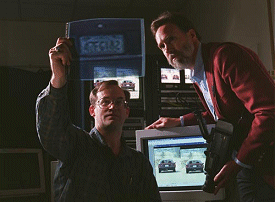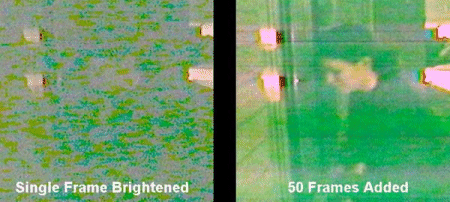|
Two NASA scientists are working with the police and the FBI to track
down criminals using out-of-this-world video technology.
NASA
FBI and other law enforcement officers
- whose investigations are normally down-to-Earth - have been seeking
the help of two NASA scientists who study the Sun and storms like
hurricanes.
Why are specialists from such different worlds working together?
The NASA researchers, using their expertise and equipment for analysing
satellite video -- created technology that can dramatically improve
TV images including crime scene videos. With law enforcement officers
looking over their shoulders, the scientists use their computer
software to turn dark, jittery images captured by home video, security
systems and video cameras in police cars into clearer, stable images
that reveal clues about crimes.
David Hathaway and Paul Meyer at NASA's
Marshall Space Flight Centre in Huntsville, Alabama, have worked
on over a dozen criminal cases with the police and FBI. Hathaway,
a solar physicist, is usually busy studying images of violent explosions
on the Sun, and Meyer, an atmospheric scientist, examines hazardous
weather conditions on Earth. The scientists' foray into the world
of forensics began when they helped the FBI analyse video of the
bombing that killed two people and injured hundreds more at the
1996 Olympic Summer Games in Atlanta. Hathaway and Meyer successfully
clarified night-time videotapes made with handheld camcorders, revealing
important details about the bomb and the explosion.
Since their first case with the FBI, Hathaway and Meyer have worked
over the years to refine the VISAR technology, improving it so that
it has now been transferred to companies that produce video enhancement
systems for law enforcement, the military and even home computers.

NASA inventors
Paul Meyer (left) and David Hathaway view a license plate
number revealed by using the Video Image Stabilisation and
Registration -- VISAR -- software to improve poor quality
footage. Meyer and Hathaway invented the software at NASA's
Marshall Space Flight Centre in Huntsville, Alabama.
|
The FBI and other criminal investigators
are able to use the NASA technology at their own stations. The NASA
scientists' invention -- called Video Image Stabilisation and Registration,
or VISAR - is available in a video tracking and enhancement system
developed by Intergraph
Government Solutions, a subsidiary of Intergraph Corp. of Huntsville.
The company has signed a licensing agreement with NASA to use VISAR
in its Video Analyst System, which offers broadcast-quality analysis
features on Intel-based hardware.
|
The skier
seems to glide across the water when video made with
a digital handheld camcorder (below) is enhanced using
VISAR (above).
|
|
|
"After analysing crime video for detectives
and seeing the horrible details of some of these crimes, it gives
me great satisfaction that police can use NASA technology to put murderers
behind bars," said Hathaway.
Hathaway, for example, helped enhance security camera videotape made
during the kidnapping of a Minnesota teenager. In an intensive effort,
the FBI and police worked with Hathaway to identify the abductor and
try to find the teenager before she was harmed. Police now believe
she was killed. The tape was later used as evidence in the trial of
a man convicted of the murder.
The VISAR system has proved so useful because it is able to correct
the effects of jitter, rotation and zoom from frame to frame in video.
Once corrected, the registered video images may then be combined to
produce clearer images.
"At NASA, we routinely take satellite images of storm clouds and enhance
them to see what is going on in the atmosphere," said Meyer. "Looking
for clues about what is happening in a storm is similar to being a
detective and finding out what took place at a crime scene."
Commercial interest in licensing the Marshall invention is based on
its ability to do more than just remove noise or "snow" from videos.
The software also corrects for horizontal and vertical camera motion,
as well as rotation and zoom effects. It produces clearer images of
moving objects, smoothes jagged edges and enhances still images.
"By adding VISAR to our Video Analyst
Workstation, we can now offer the law enforcement, military, intelligence
and security communities these powerful capabilities in a comprehensive
video analysis system," said Trey McKay, executive manager of Federal
Hardware Solutions at Intergraph Government Solutions.

Photo: David Hathaway, NASA Marshall Space Flight Centre
VISAR can reveal
valuable clues from videos taken in extremely low light. The
single frame (left) taken at night, was brightened, enhancing
details and reducing noise, or "snow." To further overcome
the video's defects in one frame, scientists at NASA's Marshall
Space Flight Centre in Huntsville, Alabama, used VISAR software
to add information from multiple frames to reveal a person.
To create the clarified image (right), images from less than
a second of videotape were added together.
|
Video imagery for defence applications
has also been improved through another licensing agreement between
NASA and BARCO Inc. Display Systems,
of Duluth, Ga. The company has incorporated VISAR into its new computer
hardware, designed for real-time video image enhancement, stabilisation,
and tracking.
"The reconnaissance video imagery made
by military vehicles, aircraft and ships travelling in harsh, rugged
environments is often shaky and unstable," said Michael Garner,
a BARCO business analyst. "Our defence industry customers will be
pleased with the improvements NASA's software makes to reconnaissance
and surveillance video."
To evaluate the use of the video enhancement
software for medical purposes, Meyer and Hathaway have been working
with the Casey Eye Institute at the Oregon Health Sciences University
in Portland through a NASA Space Act Agreement. Officials at the
institute have called the video evaluations "awesome." Through partnerships
with the National Eye Institute of the National Institutes of Health,
scientists at the Portland institute use an innovative technique
to study video of cell movements in the eye associated with immune
system diseases.
"Working with the NASA software, we can answer questions that advance
our understanding of processes unique to the eye and our understanding
of how the immune system works," said Stephen R. Planck, associate
professor for the Casey Institute. "After NASA enhanced the video,
we could see cell movements inside the eye that were undetectable
before."
|
